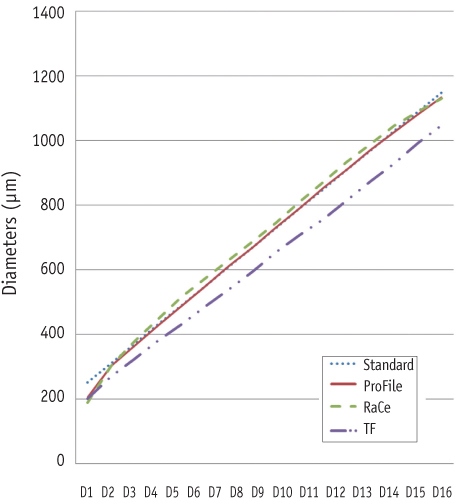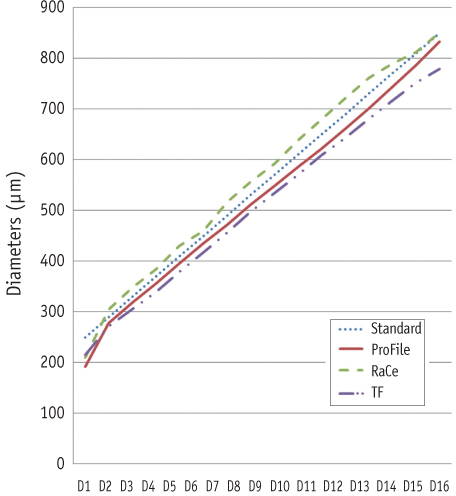Restor Dent Endod.
2014 Feb;39(1):7-11.
A comparison of dimensional standard of several nickel-titanium rotary files
- Affiliations
-
- 1Department of Conservative Dentistry, Gangneung-Wonju National University College of Dentistry, Gangneung, Korea. mendo7@gwnu.ac.kr
- 2Department of Dental Biomaterials, Gangneung-Wonju National University College of Dentistry, Gangneung, Korea.
- 3Department of Endodontics, University of Pennsylvania, Philadelphia School of Dental Medicine, USA.
Abstract
OBJECTIVES
The aim of this study was to compare the dimensional standard of several nickel-titanium (Ni-Ti) rotary files and verify the size conformity.
MATERIALS AND METHODS
ProFile (Dentsply Maillefer), RaCe (FKG Dentaire), and TF file (SybronEndo) #25 with a 0.04 and 0.06 taper were investigated, with 10 in each group for a total of 60 files. Digital images of Ni-Ti files were captured under light microscope (SZX16, Olympus) at 32x. Taper and diameter at D1 to D16 of each files were calculated digitally with AnalySIS TS Materials (OLYMPUS Soft Imaging Solutions). Differences in taper, the diameter of each level (D1 to D16) at 1 mm interval from (ANSI/ADA) specification No. 101 were statistically analyzed using one-way ANOVA and Scheffe's post-hoc test at 95% confidence level.
RESULTS
TF was the only group not conform to the nominal taper in both tapers (p < 0.05). All groups except 0.06 taper ProFile showed significant difference from the nominal diameter (p < 0.05).
CONCLUSIONS
Actual size of Ni-Ti file, especially TF, was different from the manufacturer's statements.
Keyword
MeSH Terms
Figure
Reference
-
1. Yoon MJ, Song MJ, Shin SJ, Kim E. Comparison of apical transportation and change of working length in K3, NRT and ProFile rotary instruments using transparent resin block. J Korean Acad Conserv Dent. 2011; 36:59–65.
Article2. Ruddle CJ. Nickel-titanium rotary instruments: current concepts for preparing the root canal system. Aust Endod J. 2003; 29:87–98.
Article3. Ingle JI. The need for endodontic instrument standardization. Oral Surg Oral Med Oral Pathol. 1955; 8:1211–1213.
Article4. Grossman LI. Transactions of the second international conference on endodontics. In : Ingle JI, Levine M, editors. The need for uniformity of endodontic instruments, equipment and filling materials. Philadelphia: University of Pennsylvania Press;1958. p. 123–142.5. Stenman E, Spångberg LS. Root canal instruments are poorly standardized. J Endod. 1993; 19:327–334.
Article6. Ingle JI. A standardized endodontic technique utilizing newly designed instruments and filling materials. Oral Surg Oral Med Oral Pathol. 1961; 14:83–91.
Article7. Heuer M. The biomechanics of endodontic therapy. Dent Clin North Am. 1963; 13:341–359.8. American Dental Association Council on Dental Materials, Instruments, and Equipment. Revised ANSI/ADA specification no. 28: root canal files and reamers, type K. 1981.9. American Dental Association Council on Scientific Affairs. ANSI/ADA specification no. 28: root canal files and reamers, type K. 2008.10. ISO-Standards ISO 3630 Dentistry-Root canal instruments - Part 1: General requirements and test methods. Geneve: International Organization for Standardization;2008. p. 1–18.11. American Dental Association Council on Scientific Affairs. ANSI/ADA specification no. 101: root canal instruments-general requirements. 2001.12. Zinelis S, Magnissalis EA, Margelos J, Lambrianidis T. Clinical relevance of standardization of endodontic files dimensions according to the ISO 3630-1 specification. J Endod. 2002; 28:367–370.
Article13. Keate KC, Wong M. Comparison of endodontic file tip quality. J Endod. 1990; 16:486–491.14. Cormier CJ, von Fraunhofer JA, Chamberlain JH. A comparison of endodontic file quality and file dimensions. J Endod. 1988; 14:138–142.
Article15. Dearing GJ, Kazemi RB, Stevens RH. An objective evaluation comparing the physical properties of two brands of stainless steel endodontic hand files. J Endod. 2005; 31:827–830.
Article16. Schäfer E, Dzepina A, Danesh G. Bending properties of rotary nickel-titanium instruments. Oral Surg Oral Med Oral Pathol Oral Radiol Endod. 2003; 96:757–763.
Article17. Lask JT, Walker MP, Kulild JC, Cunningham KP, Shull PA. Variability of the diameter and taper of size #30, 0.04 nickel-titanium rotary files. J Endod. 2006; 32:1171–1171.
Article18. Hatch GW, Roberts S, Joyce AP, Runner R, McPherson JC 3rd. Comparative study of the variability of 0.06 tapered rotary endodontic files to current taper standards. J Endod. 2008; 34:463–465.
Article19. Gambarini G, Grande NM, Plotino G, Somma F, Garala M, De Luca M, Testarelli L. Fatigue resistance of engine-driven rotary nickel-titanium instruments produced by new manufacturing methods. J Endod. 2008; 34:1003–1005.
Article20. El Batouty KM, Elmallah WE. Comparison of canal transportation and changes in canal curvature of two nickel-titanium rotary instruments. J Endod. 2011; 37:1290–1292.
Article21. Gambarini G, Gerosa R, De Luca M, Garala M, Testarelli L. Mechanical properties of a new and improved nickel-titanium alloy for endodontic use: an evaluation of file flexibility. Oral Surg Oral Med Oral Pathol Oral Radiol Endod. 2008; 105:798–800.
Article22. Oh SR, Chang SW, Lee Y, Gu Y, Son WJ, Lee W, Baek SH, Bae KS, Choi GW, Lim SM, Kum KY. A comparison of nickel-titanium rotary instruments manufactured using different methods and cross-sectional areas: ability to resist cyclic fatigue. Oral Surg Oral Med Oral Pathol Oral Radiol Endod. 2010; 109:622–628.
Article23. Kim HC, Yum J, Hur B, Cheung GS. Cyclic fatigue and fracture characteristics of ground and twisted nickel-titanium rotary files. J Endod. 2010; 36:147–152.
Article24. Hou X, Yahata Y, Hayashi Y, Ebihara A, Hanawa T, Suda H. Phase transformation behaviour and bending property of twisted nickel-titanium endodontic instruments. Int Endod J. 2011; 44:253–258.
Article25. Camps JJ, Pertot WJ. Relationship between file size and stiffness of stainless steel instruments. Endod Dent Traumatol. 1994; 10:260–263.
Article26. Camps JJ, Pertot WJ, Levallois B. Relationship between file size and stiffness of nickel-titanium instruments. Endod Dent Traumatol. 1995; 11:270–273.
Article27. Schäfer E, Tepel J. Relationship between design features of endodontic instruments and their properties. Part 3. Resistance to bending and fracture. J Endod. 2001; 27:299–303.
Article28. Turpin YL, Chagneau F, Vulcain JM. Impact of two theoretical cross-sections on torsional and bending stresses of nickel-titanium root canal instrument models. J Endod. 2000; 26:414–417.
Article29. Kim BH, Choi KK, Park SH, Choi GW. A comparison of the shaping ability of four rotary nickel-titanium files in simulated root canals. J Korean Acad Conserv Dent. 2010; 35:88–95.
Article
- Full Text Links
- Actions
-
Cited
- CITED
-
- Close
- Share
- Similar articles
-
- Shaping ability of Ni-Ti rotary files in combination with GT rotary Ni-Ti file
- Influence of root canal curvature on the screw-in effect of nickel-titanium rotary files in simulated resin root canal
- Effect of various canal preparation techniques using rotary nickel-titanium files on the maintenance of canal curvature
- Effect of adaptive motion on cyclic fatigue resistance of a nickel titanium instrument designed for retreatment
- Shaping ability of nickel-titaniumrotary files




